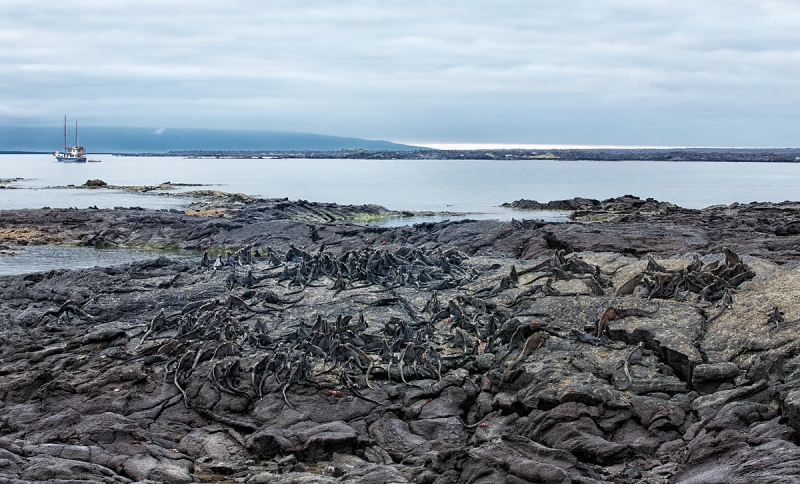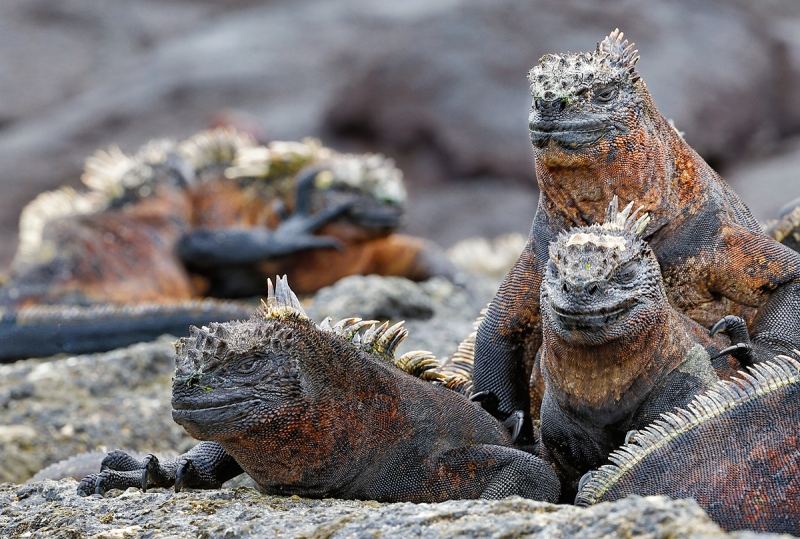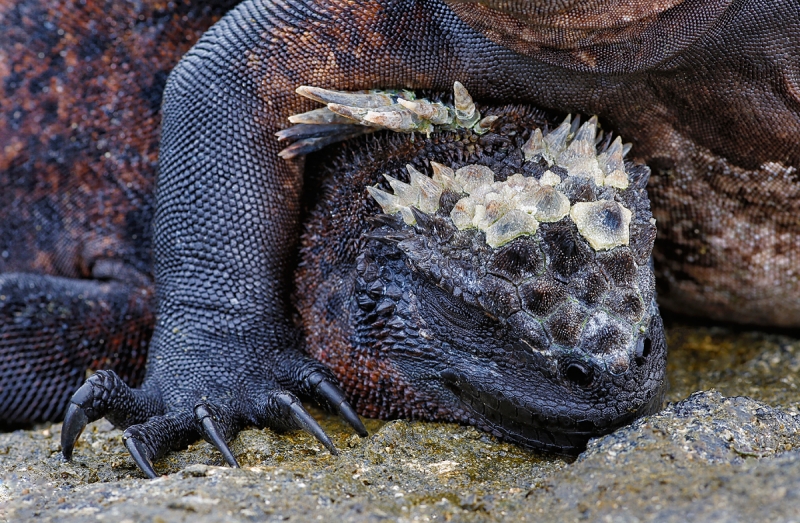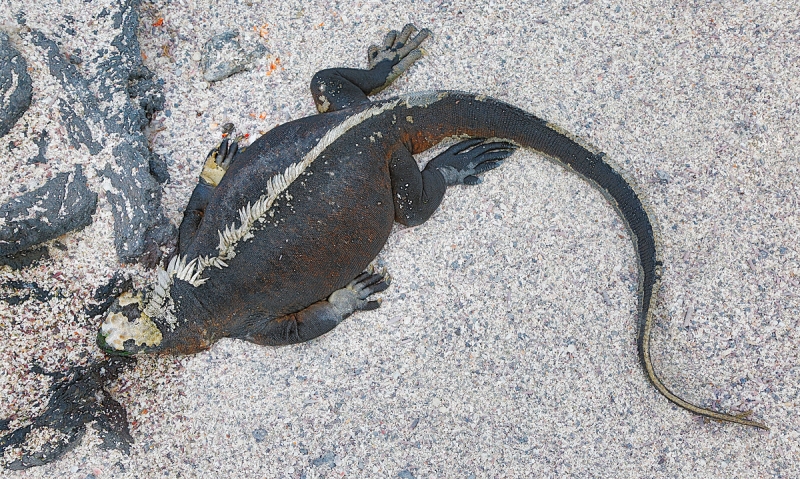Day 5 Morning Wet Landing, Punta Espinoza, Fernandina Part I
|
This image was created with the tripod-mounted Canon EF 70-200mm f/2.8L IS II lens (at 80mm) and the the Canon EOS 5D Mark III Digital camera body. ISO 400. Evaluative metering +2/3 stop: 1/5 sec. at f/16 in Av mode. |
All the Weapons: Part I
This being my eighth Galapagos Photo-Cruise, I am familiar with all of the regular landings. At Punta Espinoza, I knew that I would need to bring the whole arsenal: the 600 II, the new 200-400, the 70-200 II, and the 24-105. I used all of them on what turned out to be a wonderful morning.
As always, we boarded the pangas (zodiacs) in the pre-dawn darkness at about 5:45am. After a dry landing we worked the large groups of Marine Iguanas on the lava rock shoreline. I used my tulip sharpness techniques: Live View for Mirror Lock and 2-second timer. I tried several Art Vivid HDRs of the wide scene above but liked the straight image best of all. I used my favorite NIK Color Efex Pro 50/50 combo on the whole image: 50% Detail Extractor and 50% Tonal Contrast. It performed wonders. Then I ran a layer of Surface Blur (thanks Denise Ippolito for that great trick) on the sky and the water to remove the noise brought up by the Detail Extractor filter.
|
This 3-frame in-camera Art Vivid HDR image was created with the tripod-mounted Canon EF 200-400mm f/4L IS USM Lens with Internal 1.4x Extender (at 232mm) and the Canon EOS 5D Mark III Digital Camera (Body Only). ISO 400. Evaluative metering +1/3 stop: 1/6 sec. at f/14. Central sensor/AI Servo-Surround/Rear Focus AF on the eye of the front left Marine Iguana and re-compose. Click here if you missed the Rear Focus Tutorial. Click on the image to see a larger version. |
The Marine Iguanas
These prehistoric-looking reptiles gather in large groups in the early morning hours and then make their way down to the sea to graze on algae either on the rocks at low tide or by swimming along the bottom. It is a wonder to see them in motion and feeding while snorkeling; we got to see them in the water at several locations in the northwest quadrant of the archipelago. Photographers could not ask for more cooperative early morning subjects; for the most part, they sit stock-still on the rocks for more than an hour until they are warmed by the sun or the brightening of the day. Here again I used my tulip sharpness techniques. My favorite iguana in this image is the one in the scratching pose in the upper left part of the frame.
|
This is another 3-frame in-camera Art Vivid HDR image that was created with the tripod-mounted Canon EF 200-400mm f/4L IS USM Lens with Internal 1.4x Extender (with the internal TC in place at 560mm) and the Canon EOS 5D Mark III Digital Camera (Body Only). ISO 400. Evaluative metering -1/3 stop: 1/8 sec. at f/14. Central sensor/AI Servo-Surround/Rear Focus AF on the closed right eye of the iguana and re-compose. Click here if you missed the Rear Focus Tutorial. Click on the image to see a larger version. |
Ugly but Cute
The Marine Iguanas have a way of winding up in the most endearing poses. When I saw this tight scene with one lizard’s foot draped over the top of its neighbor’s head, I approached low and slow, engaged the internal 1.4X TC, framed the image, and went to work creating another in-camera Art Vivid HDR. Again, my tulip techniques and the stillness of the creatures allowed for the creation of a sharp image. The relatively long, sharp toes give the animals an excellent grip on the slimy, seaweed-covered rocks. The white pyramids on the front of the head are extruded salt crystals.
|
This 3-frame in-camera Art Vivid HDR image was created with the hand held Canon 24-105mm f/4L IS EF USM AF Lens(at 47mm) and the Canon EOS 5D Mark III Digital camera body ISO 800. Evaluative metering +1 2/3 stops yielded a base exposure of 1/200 sec. at f/9 in Manual mode (+/-2 stops). Three sensors left of the central sensor/AI Servo Rear Focus AF on the spines on the iguana’s upper back active at the moment of exposure. Click here if you missed the Rear Focus Tutorial. Be sure to click on the image to enjoy a larger version. |
Hand Held In-camera HDRs
While it is always best to be on tripod for HDRs, it is not always feasible to bring along the Giotto’s tiny ballhead and the Wimberley P-5 camera body plate. Raise your ISO if you need a slightly higher shutter speed and be sure to brace yourself securely when pressing the shutter button. Having Auto Align checked in the HDR menu will take care of most alignment problems so long as nothing is moving. If the latter, you will wind up with usually unattractive black outlines around the moving creatures.
On The Road Again
Please know that I will be traveling to and from the Africa for the Tanzania Photo Safari with Todd Gustafson leaving today, August 1 and back in the office on August 21. I will have extremely limited and very slow at best internet access so please do not e-mail me until I get back. Jim will be in the office every weekday to help you with your mail order purchases and Jen will be here handling IPT registrations. The blog will continue to be active as I have prepared a dozen interesting, brand new educational posts for you in advance for you to enjoy during my absence.
Please consider using our B&H, Amazon, and Borrow Lenses affiliate links for all of your major and minor purchases both photographic and household. If we carry something in the BAA Store that you need our very great preference would be that you purchase those items from us :).
If you have a gear, image processing, or other question please e-mail me after July 19th. You can reach Jim here via e-mail. You can reach Jennifer here via e-mail. Please type “JIM” or “JEN” respectively at the front of the Subject Line.
Shooters Gallery Photography Group Program
October 20, 2013. Salem, CT
Artie Morris & Denise Ippolito
Date: Sunday – October 20, 2013: Time: 9:00am – 4:00pm
Location: Salem Gardner Lake Firehouse Hall, 429 Old Colchester Road, Salem, CT 06420
Admission Fee: The Artie Morris presentation from 9:00am until 10:45am is free and open to the public courtesy of Canon U.S.A.
The presentation by Artie and Denise from 11:00am until 4:00pm is $40.00 (Lunch & morning coffee included)
9:00 to 10:45 – “Choosing and Using Lenses for Nature Photography… BIRDS AS ART Style” – Artie Morris (Sponsored by Canon U.S.A.)
10:45 TO 11:00: Break
11:00 to 12:00 – “Blooming Ideas” – Denise Ippolito
12:00 to 1:00 – Lunch
1:00 to 2:00 – “Refining Your Photographic Vision” – Artie Morris and Denise Ippolito
2:00 to 2:30 – “Pro Gear Handling Tips” – Artie Morris and Denise Ippolito
2:30 to 2:45 – Break
2:45 to 4:00 – “Creating Pleasing Blurs” – Artie Morris and Denise Ippolito
Click here to register.
Bucket List?
If visiting the Galapagos is on your bucket list and you are a happy camper who is serious about joining us on our July 2015 trip, please shoot me an e-mail and ask to be placed on the interested list. There simply is no better Galapagos Photo Tour. Right now there are 16 names on the interested list with only 12 slots available.
Typos
On all blog posts, feel free to e-mail or leave a comment regarding any typos, wrong words, misspellings, omissions, or grammatical errors. Just be right. 🙂
Support the BAA Blog. Support the BAA Bulletins: Shop B&H here!
We want and need to keep providing you with the latest free information, photography and Photoshop lessons, and all manner of related information. Show your appreciation by making your purchases immediately after clicking on any of our B&H or Amazon Affiliate links in this blog post. Remember, B&H ain’t just photography!




Support the Blog


Amazon
Everyone buys something from Amazon, be it a big lens or deodorant. Support the blog by starting your search by typing in the little white box below. No purchase is too small to be appreciated; they all add up. Why make it a habit? Because I make it a habit of bringing you new images and information on an almost daily basis.
And from the BAA On-line Store:
LensCoats. I have a LensCoat on each of my big lenses to protect them from nicks and thus increase their re-sales value. All my big lens LensCoat stuff is in Hardwood Snow pattern.
LegCoat Tripod Leg Covers. I have four tripods active and each has a Hardwood Snow LegCoat on it to help prevent further damage to my tender shoulders 🙂 And you will love them in mega-cold weather….
Gitzo GT3532 LS CF Tripod. This one replaces the GT3530LS Tripod and will last you a lifetime. Learn more about this great tripod here.
Mongoose M3.6 Tripod Head. Right now this is the best tripod head around for use with lenses that weigh less than 9 pounds. For heavier lenses, check out the Wimberley V2 head.
Double Bubble Level. You will find one in my camera’s hot shoe whenever I am not using flash.
The Lens Align Mark II. I use the Lens Align Mark II pretty much religiously to micro-adjust all of my gear an average of once a month and always before a major trip. Enjoy our free comprehensive tutorial here.
BreezeBrowser. I do not see how any digital photographer can exist without this program.
Delkin Flash Cards. I use and depend on Delkin compact Flash Cards and card readers most every day. Learn more about their great 700X and 1000X cards here or about my favorite Delkin card here.


















Thank you, Sir!
“I used my favorite NIK Color Efex Pro 50/50 combo on the whole image: 50% Detail Extractor and 50% Tonal Contrast. It performed wonders. Then I ran a layer of Surface Blur (thanks Denise Ippolito for that great trick) on the sky and the water to remove the noise brought up by the Detail Extractor filter.”
Hi Mate, I may not comment much; I never fail to read! 🙂
Where can I find an expanded explanation (Denise?) – I am sure you wrote already/I am sure I missed! 🙁 : the use of the Surface Blur?
Thanks and best regards,
Jay
PS: They are ugly; they are beautiful as captured, processed, and presented.
Hi Jay,
Hey. We have a nice Aussie couple with us on safari: John and Jane Cornish.
Complete details on both the 50-50 bit and on Surface Blur may be found in the latest (free as always) update of Digital Basics.
best, artie
It was a great trip, you always do such a great job capturing these guys.
Thanks Neesie. We sure had fun. There is tons of interest in the 2015 trip and it looks as if the Sparkman’s may be coming again! Robin is making killer panos here in Africa with her i-
phone!